ACC 566: Accounting System and Procedure: Detailed Analysis
VerifiedAdded on 2020/05/28
|23
|2794
|36
Homework Assignment
AI Summary
This assignment, prepared by a student, addresses various aspects of accounting systems and procedures. The solution begins with spreadsheet analysis, including the use of "IF" functions, and then delves into the differences between perpetual and periodic inventory systems. It covers how spreadsheets are used in accounting, including their advantages and disadvantages. The assignment includes a bank reconciliation exercise, providing both normal and formula views. Furthermore, it explores bad debt methods, comparing the direct write-off and allowance methods. The assignment also touches on the role of computers in online retailing and concludes with an analysis of the balance scorecard, using Qantas as a case study to evaluate its financial performance and non-current assets.
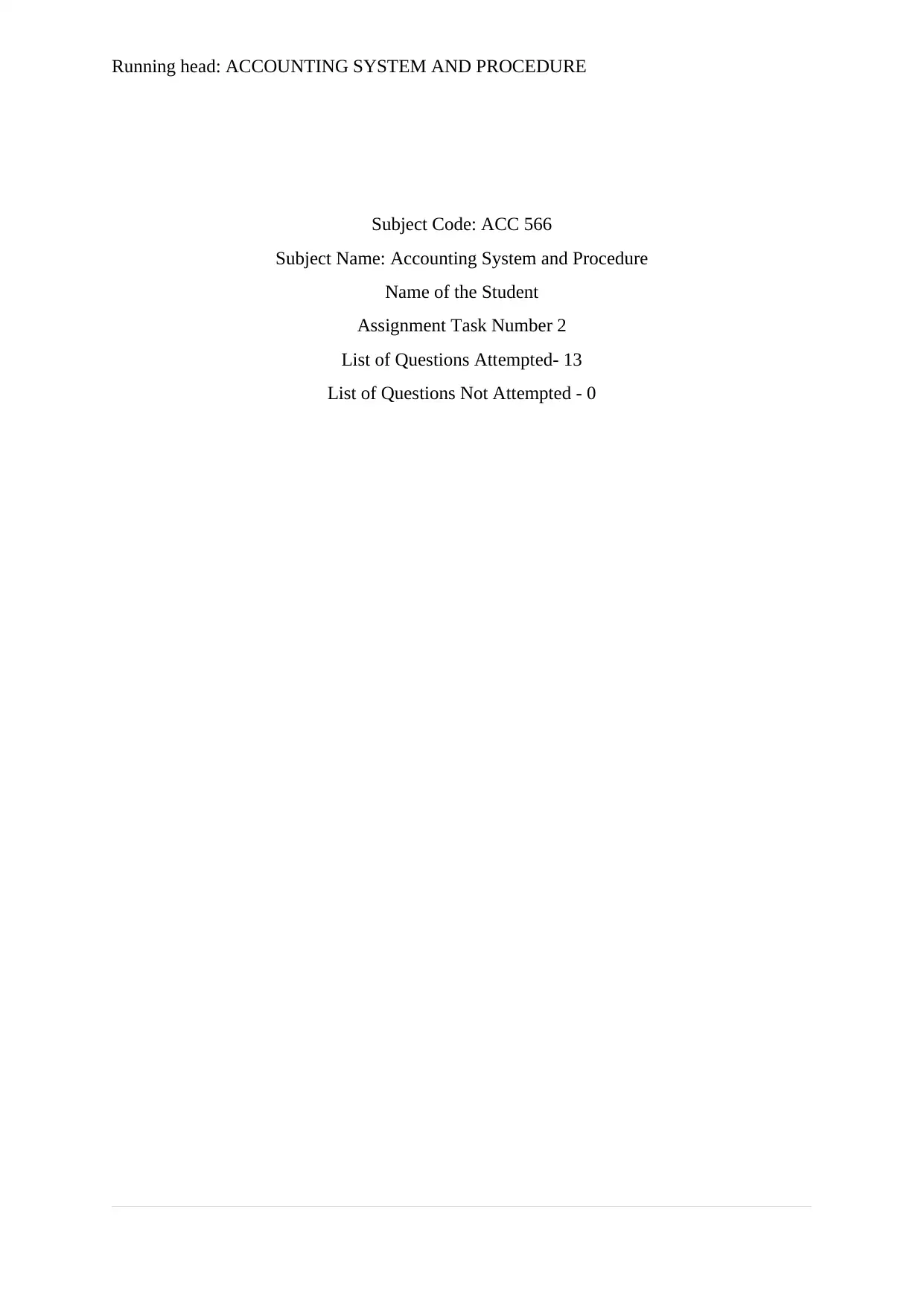
Running head: ACCOUNTING SYSTEM AND PROCEDURE
Subject Code: ACC 566
Subject Name: Accounting System and Procedure
Name of the Student
Assignment Task Number 2
List of Questions Attempted- 13
List of Questions Not Attempted - 0
Subject Code: ACC 566
Subject Name: Accounting System and Procedure
Name of the Student
Assignment Task Number 2
List of Questions Attempted- 13
List of Questions Not Attempted - 0
Paraphrase This Document
Need a fresh take? Get an instant paraphrase of this document with our AI Paraphraser
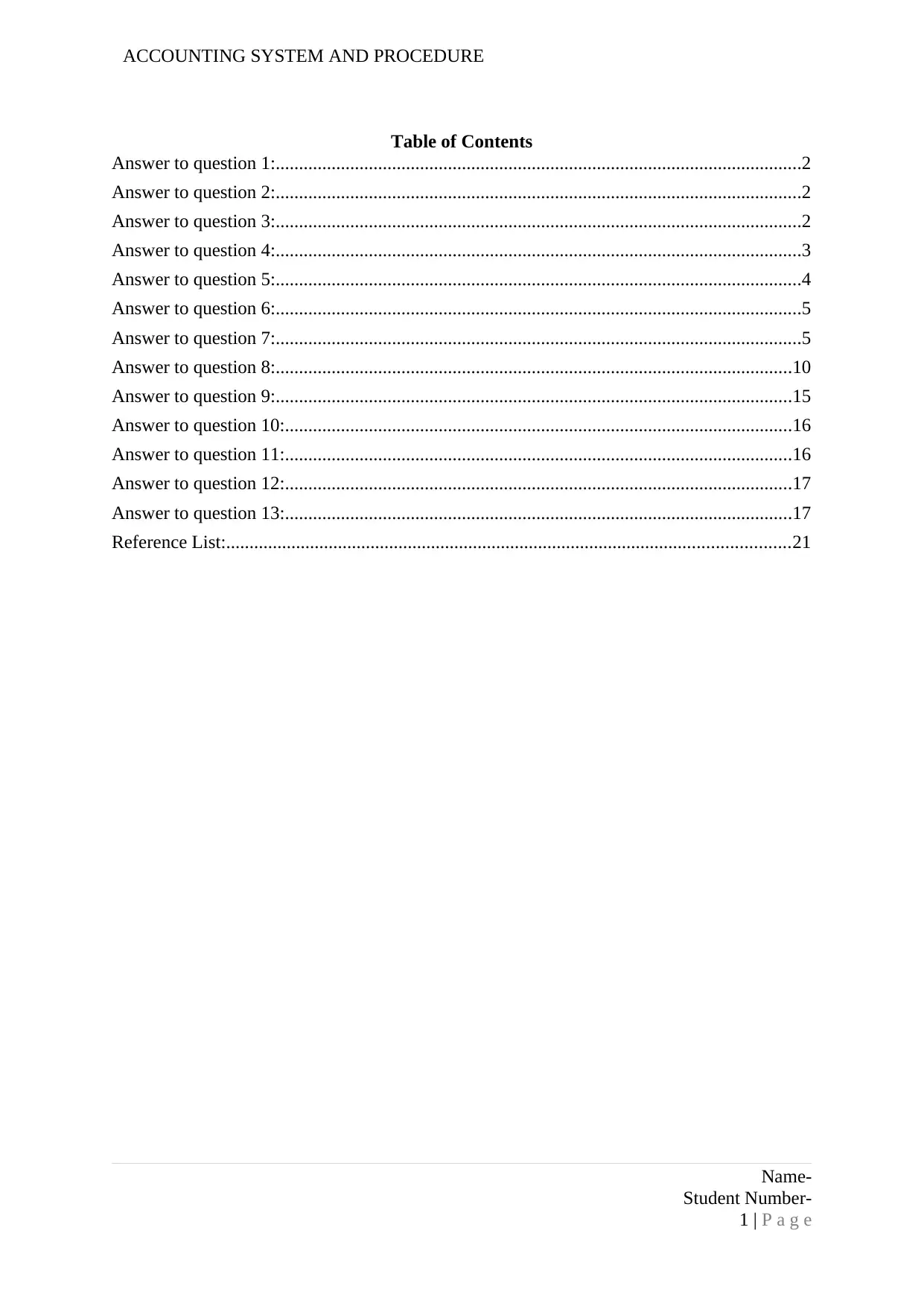
ACCOUNTING SYSTEM AND PROCEDURE
Table of Contents
Answer to question 1:.................................................................................................................2
Answer to question 2:.................................................................................................................2
Answer to question 3:.................................................................................................................2
Answer to question 4:.................................................................................................................3
Answer to question 5:.................................................................................................................4
Answer to question 6:.................................................................................................................5
Answer to question 7:.................................................................................................................5
Answer to question 8:...............................................................................................................10
Answer to question 9:...............................................................................................................15
Answer to question 10:.............................................................................................................16
Answer to question 11:.............................................................................................................16
Answer to question 12:.............................................................................................................17
Answer to question 13:.............................................................................................................17
Reference List:.........................................................................................................................21
Name-
Student Number-
1 | P a g e
Table of Contents
Answer to question 1:.................................................................................................................2
Answer to question 2:.................................................................................................................2
Answer to question 3:.................................................................................................................2
Answer to question 4:.................................................................................................................3
Answer to question 5:.................................................................................................................4
Answer to question 6:.................................................................................................................5
Answer to question 7:.................................................................................................................5
Answer to question 8:...............................................................................................................10
Answer to question 9:...............................................................................................................15
Answer to question 10:.............................................................................................................16
Answer to question 11:.............................................................................................................16
Answer to question 12:.............................................................................................................17
Answer to question 13:.............................................................................................................17
Reference List:.........................................................................................................................21
Name-
Student Number-
1 | P a g e
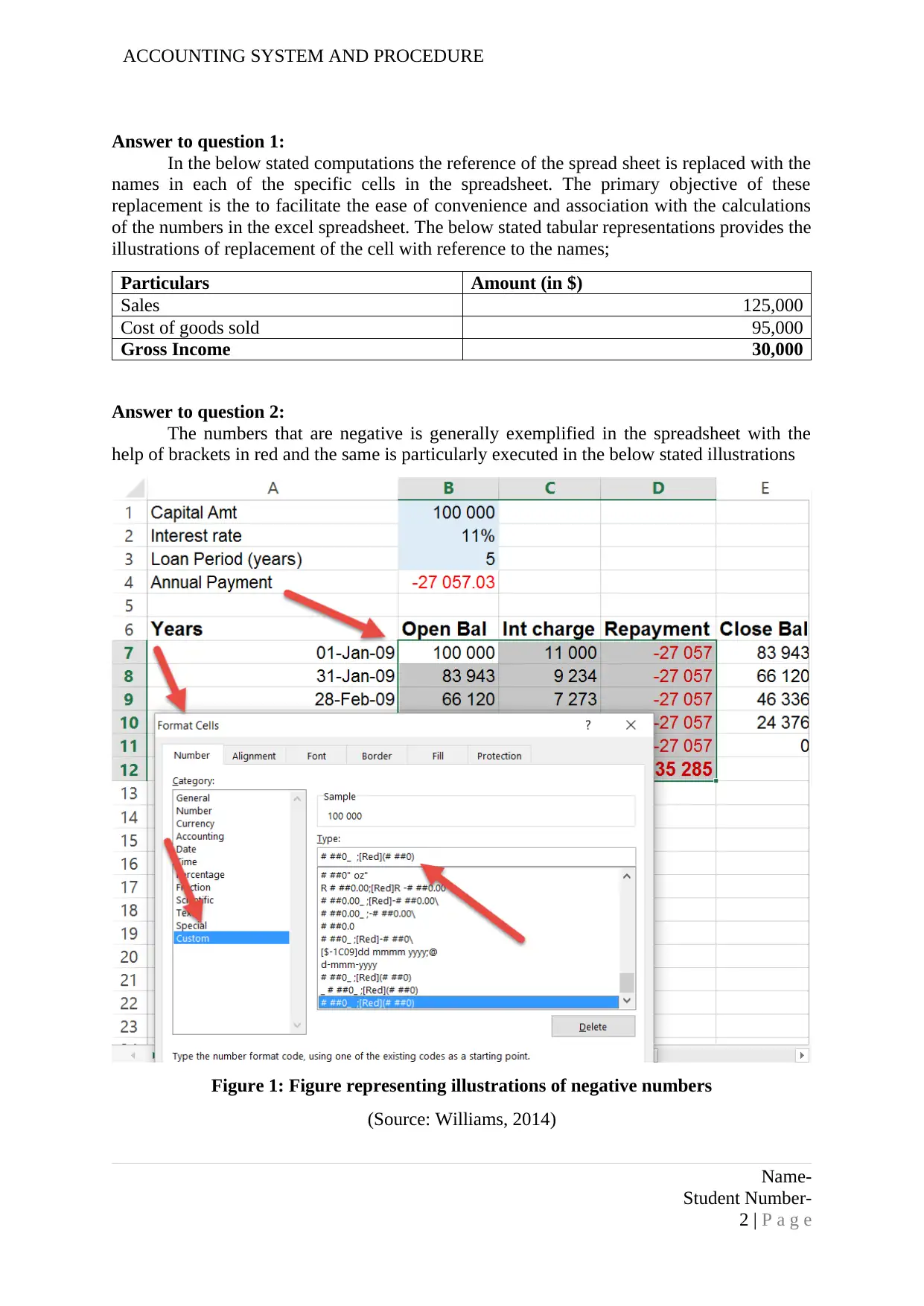
ACCOUNTING SYSTEM AND PROCEDURE
Answer to question 1:
In the below stated computations the reference of the spread sheet is replaced with the
names in each of the specific cells in the spreadsheet. The primary objective of these
replacement is the to facilitate the ease of convenience and association with the calculations
of the numbers in the excel spreadsheet. The below stated tabular representations provides the
illustrations of replacement of the cell with reference to the names;
Particulars Amount (in $)
Sales 125,000
Cost of goods sold 95,000
Gross Income 30,000
Answer to question 2:
The numbers that are negative is generally exemplified in the spreadsheet with the
help of brackets in red and the same is particularly executed in the below stated illustrations
Figure 1: Figure representing illustrations of negative numbers
(Source: Williams, 2014)
Name-
Student Number-
2 | P a g e
Answer to question 1:
In the below stated computations the reference of the spread sheet is replaced with the
names in each of the specific cells in the spreadsheet. The primary objective of these
replacement is the to facilitate the ease of convenience and association with the calculations
of the numbers in the excel spreadsheet. The below stated tabular representations provides the
illustrations of replacement of the cell with reference to the names;
Particulars Amount (in $)
Sales 125,000
Cost of goods sold 95,000
Gross Income 30,000
Answer to question 2:
The numbers that are negative is generally exemplified in the spreadsheet with the
help of brackets in red and the same is particularly executed in the below stated illustrations
Figure 1: Figure representing illustrations of negative numbers
(Source: Williams, 2014)
Name-
Student Number-
2 | P a g e
⊘ This is a preview!⊘
Do you want full access?
Subscribe today to unlock all pages.

Trusted by 1+ million students worldwide
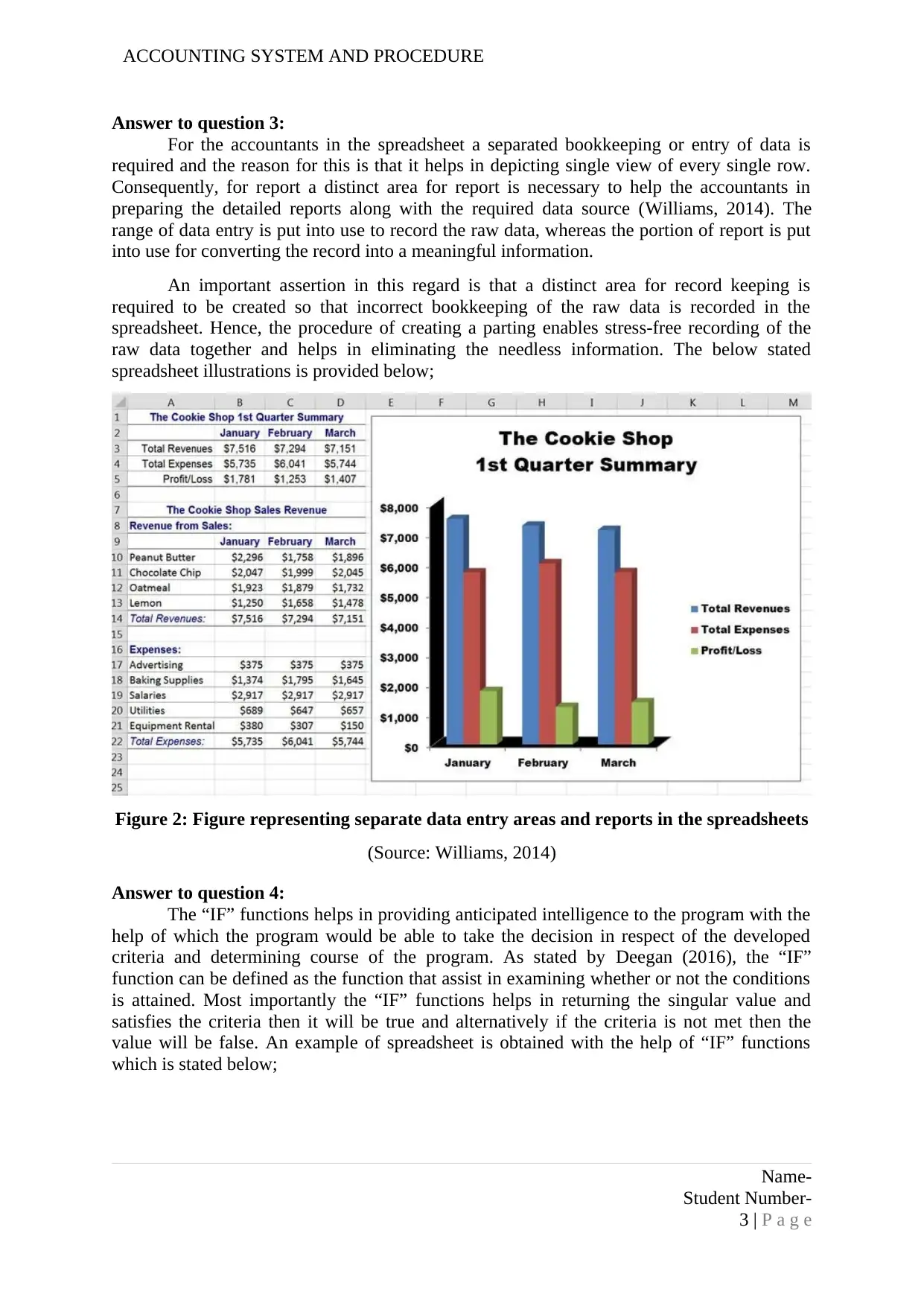
ACCOUNTING SYSTEM AND PROCEDURE
Answer to question 3:
For the accountants in the spreadsheet a separated bookkeeping or entry of data is
required and the reason for this is that it helps in depicting single view of every single row.
Consequently, for report a distinct area for report is necessary to help the accountants in
preparing the detailed reports along with the required data source (Williams, 2014). The
range of data entry is put into use to record the raw data, whereas the portion of report is put
into use for converting the record into a meaningful information.
An important assertion in this regard is that a distinct area for record keeping is
required to be created so that incorrect bookkeeping of the raw data is recorded in the
spreadsheet. Hence, the procedure of creating a parting enables stress-free recording of the
raw data together and helps in eliminating the needless information. The below stated
spreadsheet illustrations is provided below;
Figure 2: Figure representing separate data entry areas and reports in the spreadsheets
(Source: Williams, 2014)
Answer to question 4:
The “IF” functions helps in providing anticipated intelligence to the program with the
help of which the program would be able to take the decision in respect of the developed
criteria and determining course of the program. As stated by Deegan (2016), the “IF”
function can be defined as the function that assist in examining whether or not the conditions
is attained. Most importantly the “IF” functions helps in returning the singular value and
satisfies the criteria then it will be true and alternatively if the criteria is not met then the
value will be false. An example of spreadsheet is obtained with the help of “IF” functions
which is stated below;
Name-
Student Number-
3 | P a g e
Answer to question 3:
For the accountants in the spreadsheet a separated bookkeeping or entry of data is
required and the reason for this is that it helps in depicting single view of every single row.
Consequently, for report a distinct area for report is necessary to help the accountants in
preparing the detailed reports along with the required data source (Williams, 2014). The
range of data entry is put into use to record the raw data, whereas the portion of report is put
into use for converting the record into a meaningful information.
An important assertion in this regard is that a distinct area for record keeping is
required to be created so that incorrect bookkeeping of the raw data is recorded in the
spreadsheet. Hence, the procedure of creating a parting enables stress-free recording of the
raw data together and helps in eliminating the needless information. The below stated
spreadsheet illustrations is provided below;
Figure 2: Figure representing separate data entry areas and reports in the spreadsheets
(Source: Williams, 2014)
Answer to question 4:
The “IF” functions helps in providing anticipated intelligence to the program with the
help of which the program would be able to take the decision in respect of the developed
criteria and determining course of the program. As stated by Deegan (2016), the “IF”
function can be defined as the function that assist in examining whether or not the conditions
is attained. Most importantly the “IF” functions helps in returning the singular value and
satisfies the criteria then it will be true and alternatively if the criteria is not met then the
value will be false. An example of spreadsheet is obtained with the help of “IF” functions
which is stated below;
Name-
Student Number-
3 | P a g e
Paraphrase This Document
Need a fresh take? Get an instant paraphrase of this document with our AI Paraphraser
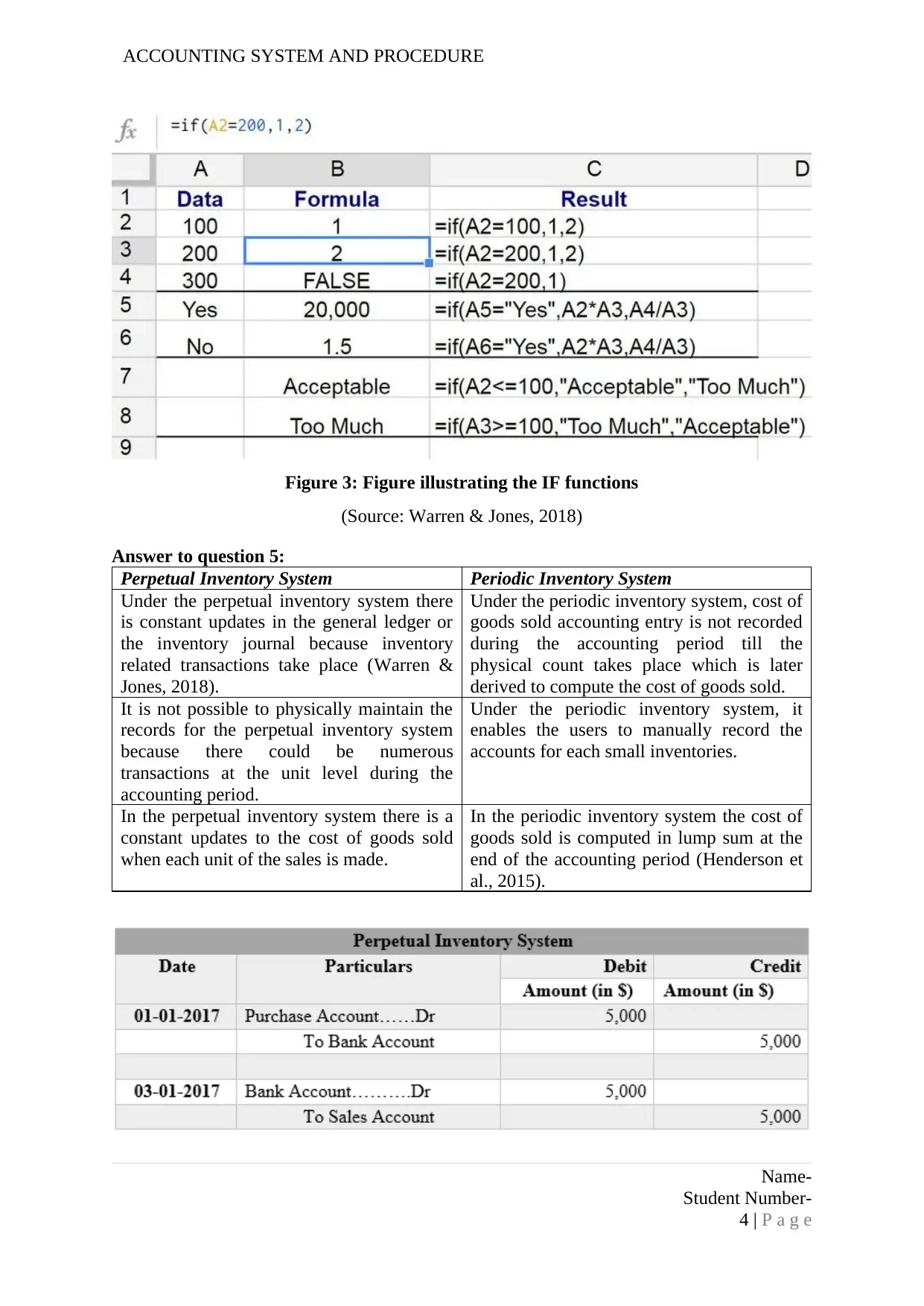
ACCOUNTING SYSTEM AND PROCEDURE
Figure 3: Figure illustrating the IF functions
(Source: Warren & Jones, 2018)
Answer to question 5:
Perpetual Inventory System Periodic Inventory System
Under the perpetual inventory system there
is constant updates in the general ledger or
the inventory journal because inventory
related transactions take place (Warren &
Jones, 2018).
Under the periodic inventory system, cost of
goods sold accounting entry is not recorded
during the accounting period till the
physical count takes place which is later
derived to compute the cost of goods sold.
It is not possible to physically maintain the
records for the perpetual inventory system
because there could be numerous
transactions at the unit level during the
accounting period.
Under the periodic inventory system, it
enables the users to manually record the
accounts for each small inventories.
In the perpetual inventory system there is a
constant updates to the cost of goods sold
when each unit of the sales is made.
In the periodic inventory system the cost of
goods sold is computed in lump sum at the
end of the accounting period (Henderson et
al., 2015).
Name-
Student Number-
4 | P a g e
Figure 3: Figure illustrating the IF functions
(Source: Warren & Jones, 2018)
Answer to question 5:
Perpetual Inventory System Periodic Inventory System
Under the perpetual inventory system there
is constant updates in the general ledger or
the inventory journal because inventory
related transactions take place (Warren &
Jones, 2018).
Under the periodic inventory system, cost of
goods sold accounting entry is not recorded
during the accounting period till the
physical count takes place which is later
derived to compute the cost of goods sold.
It is not possible to physically maintain the
records for the perpetual inventory system
because there could be numerous
transactions at the unit level during the
accounting period.
Under the periodic inventory system, it
enables the users to manually record the
accounts for each small inventories.
In the perpetual inventory system there is a
constant updates to the cost of goods sold
when each unit of the sales is made.
In the periodic inventory system the cost of
goods sold is computed in lump sum at the
end of the accounting period (Henderson et
al., 2015).
Name-
Student Number-
4 | P a g e
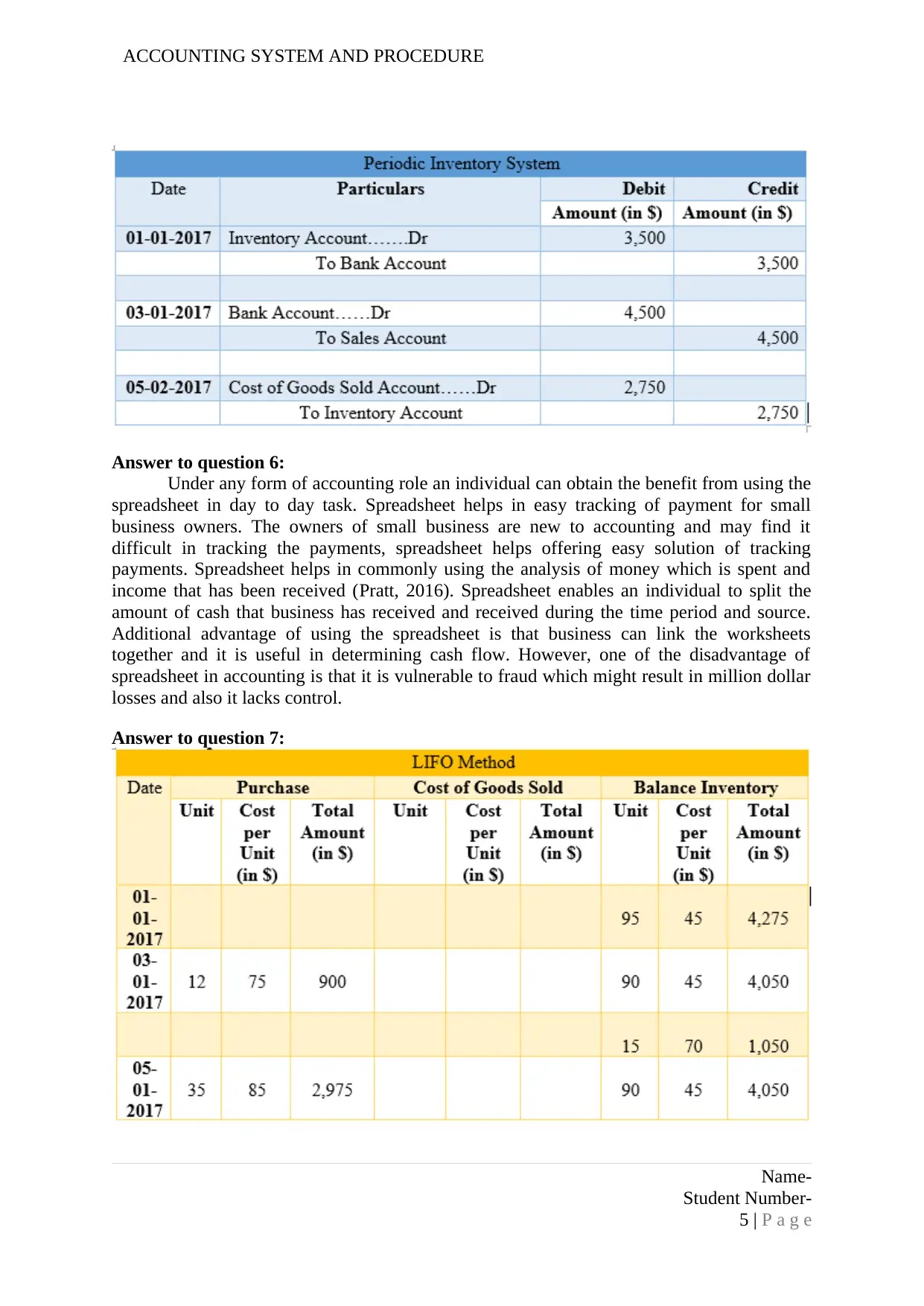
ACCOUNTING SYSTEM AND PROCEDURE
Answer to question 6:
Under any form of accounting role an individual can obtain the benefit from using the
spreadsheet in day to day task. Spreadsheet helps in easy tracking of payment for small
business owners. The owners of small business are new to accounting and may find it
difficult in tracking the payments, spreadsheet helps offering easy solution of tracking
payments. Spreadsheet helps in commonly using the analysis of money which is spent and
income that has been received (Pratt, 2016). Spreadsheet enables an individual to split the
amount of cash that business has received and received during the time period and source.
Additional advantage of using the spreadsheet is that business can link the worksheets
together and it is useful in determining cash flow. However, one of the disadvantage of
spreadsheet in accounting is that it is vulnerable to fraud which might result in million dollar
losses and also it lacks control.
Answer to question 7:
Name-
Student Number-
5 | P a g e
Answer to question 6:
Under any form of accounting role an individual can obtain the benefit from using the
spreadsheet in day to day task. Spreadsheet helps in easy tracking of payment for small
business owners. The owners of small business are new to accounting and may find it
difficult in tracking the payments, spreadsheet helps offering easy solution of tracking
payments. Spreadsheet helps in commonly using the analysis of money which is spent and
income that has been received (Pratt, 2016). Spreadsheet enables an individual to split the
amount of cash that business has received and received during the time period and source.
Additional advantage of using the spreadsheet is that business can link the worksheets
together and it is useful in determining cash flow. However, one of the disadvantage of
spreadsheet in accounting is that it is vulnerable to fraud which might result in million dollar
losses and also it lacks control.
Answer to question 7:
Name-
Student Number-
5 | P a g e
⊘ This is a preview!⊘
Do you want full access?
Subscribe today to unlock all pages.

Trusted by 1+ million students worldwide
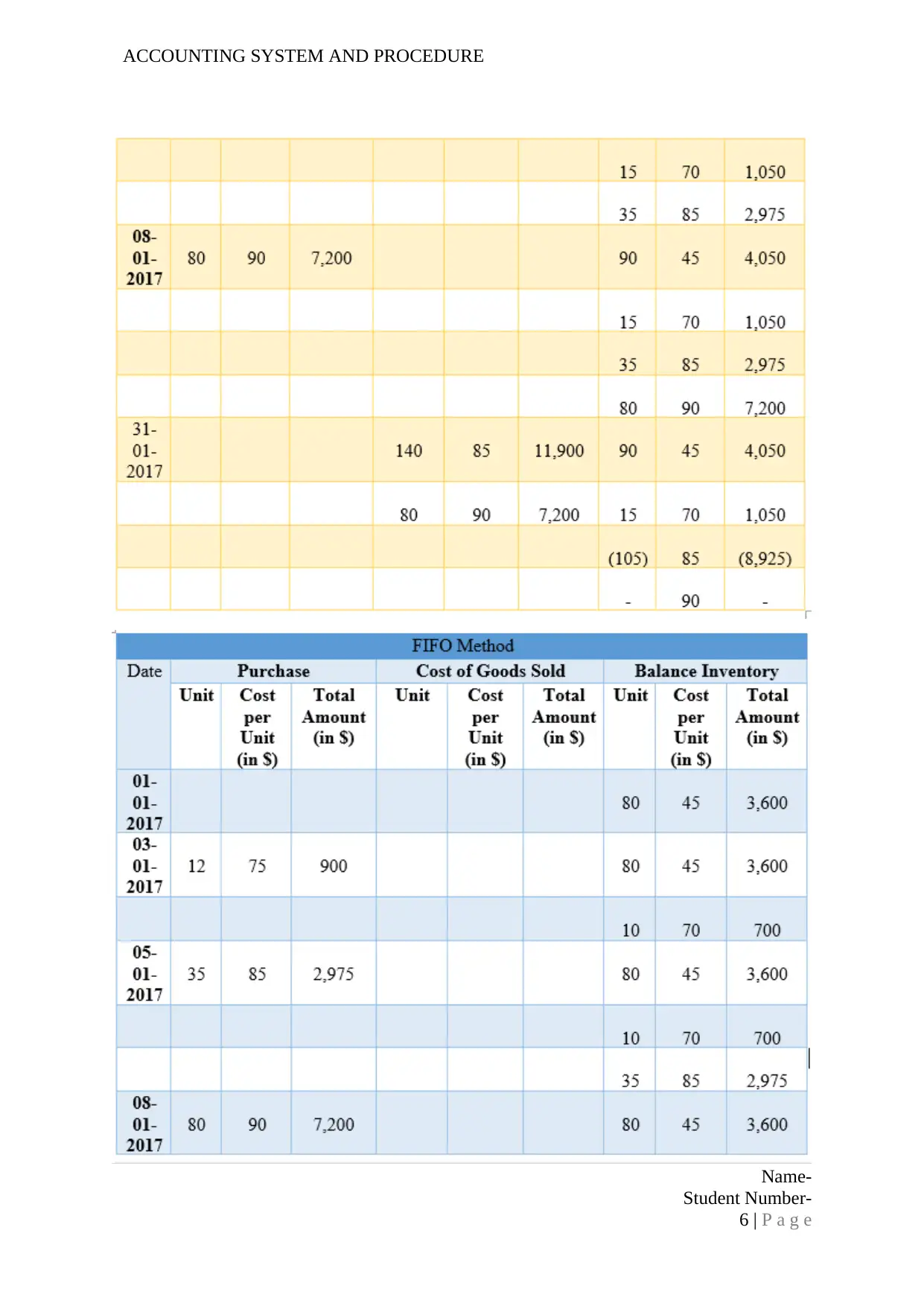
ACCOUNTING SYSTEM AND PROCEDURE
Name-
Student Number-
6 | P a g e
Name-
Student Number-
6 | P a g e
Paraphrase This Document
Need a fresh take? Get an instant paraphrase of this document with our AI Paraphraser
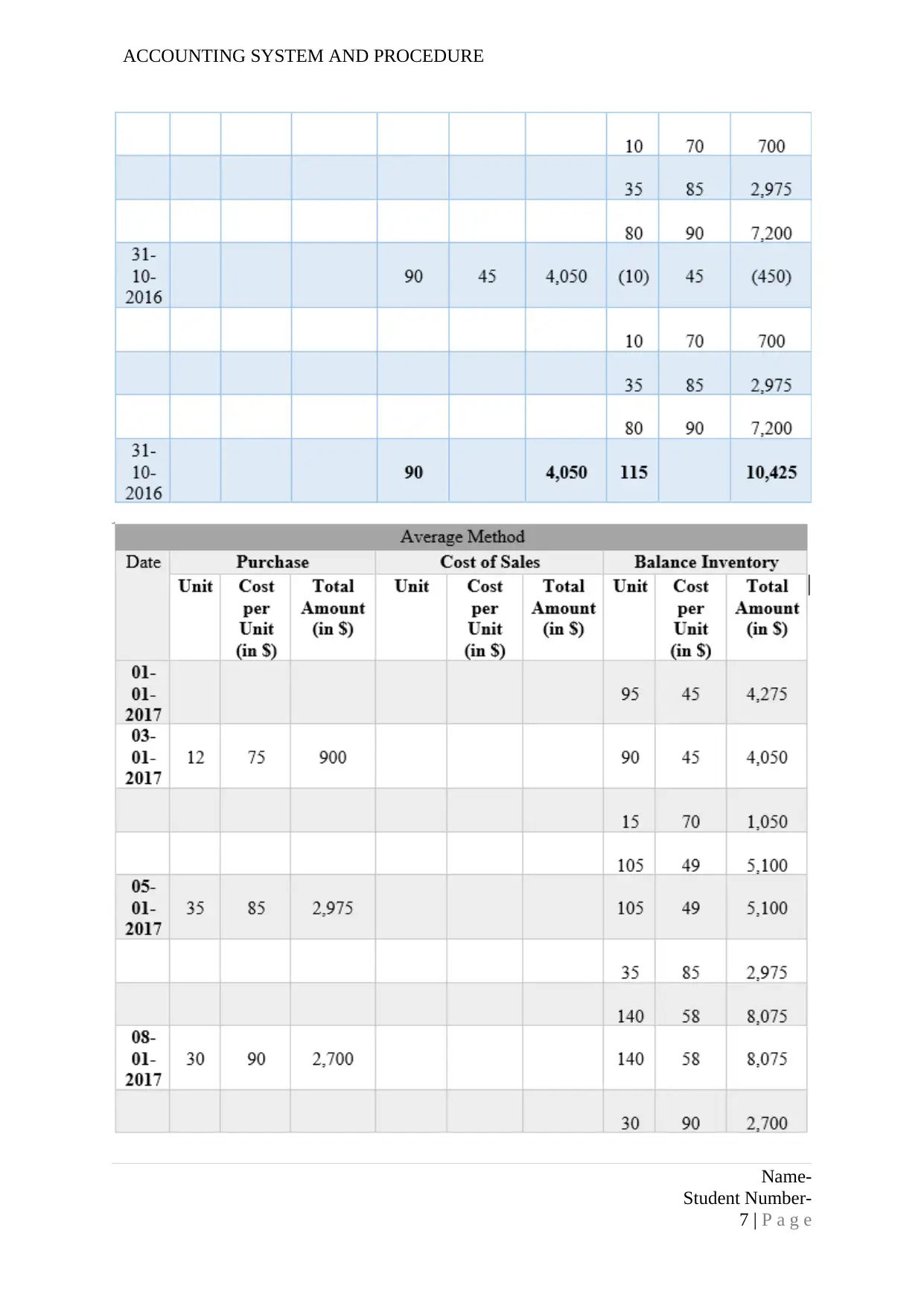
ACCOUNTING SYSTEM AND PROCEDURE
Name-
Student Number-
7 | P a g e
Name-
Student Number-
7 | P a g e
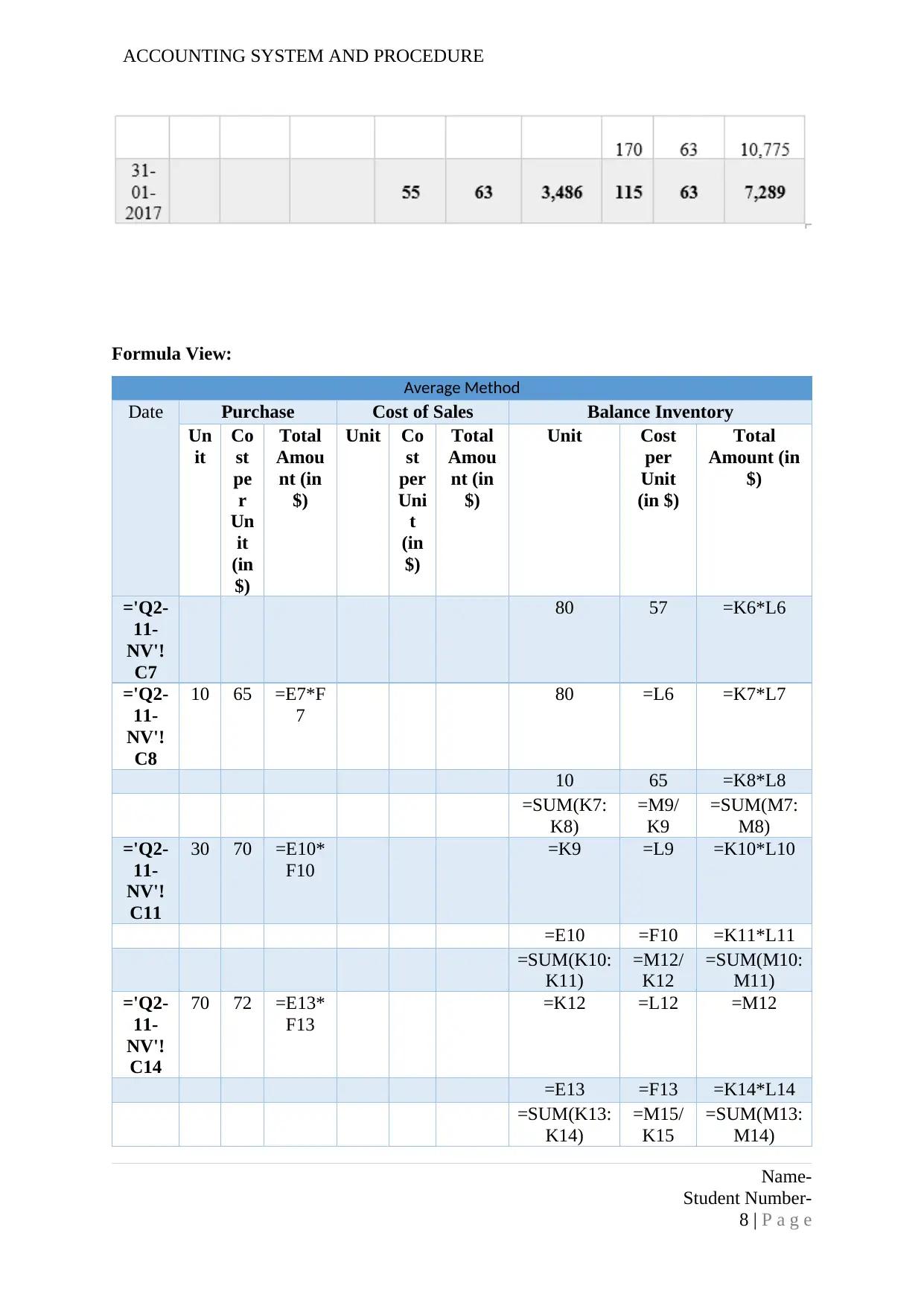
ACCOUNTING SYSTEM AND PROCEDURE
Formula View:
Average Method
Date Purchase Cost of Sales Balance Inventory
Un
it
Co
st
pe
r
Un
it
(in
$)
Total
Amou
nt (in
$)
Unit Co
st
per
Uni
t
(in
$)
Total
Amou
nt (in
$)
Unit Cost
per
Unit
(in $)
Total
Amount (in
$)
='Q2-
11-
NV'!
C7
80 57 =K6*L6
='Q2-
11-
NV'!
C8
10 65 =E7*F
7
80 =L6 =K7*L7
10 65 =K8*L8
=SUM(K7:
K8)
=M9/
K9
=SUM(M7:
M8)
='Q2-
11-
NV'!
C11
30 70 =E10*
F10
=K9 =L9 =K10*L10
=E10 =F10 =K11*L11
=SUM(K10:
K11)
=M12/
K12
=SUM(M10:
M11)
='Q2-
11-
NV'!
C14
70 72 =E13*
F13
=K12 =L12 =M12
=E13 =F13 =K14*L14
=SUM(K13:
K14)
=M15/
K15
=SUM(M13:
M14)
Name-
Student Number-
8 | P a g e
Formula View:
Average Method
Date Purchase Cost of Sales Balance Inventory
Un
it
Co
st
pe
r
Un
it
(in
$)
Total
Amou
nt (in
$)
Unit Co
st
per
Uni
t
(in
$)
Total
Amou
nt (in
$)
Unit Cost
per
Unit
(in $)
Total
Amount (in
$)
='Q2-
11-
NV'!
C7
80 57 =K6*L6
='Q2-
11-
NV'!
C8
10 65 =E7*F
7
80 =L6 =K7*L7
10 65 =K8*L8
=SUM(K7:
K8)
=M9/
K9
=SUM(M7:
M8)
='Q2-
11-
NV'!
C11
30 70 =E10*
F10
=K9 =L9 =K10*L10
=E10 =F10 =K11*L11
=SUM(K10:
K11)
=M12/
K12
=SUM(M10:
M11)
='Q2-
11-
NV'!
C14
70 72 =E13*
F13
=K12 =L12 =M12
=E13 =F13 =K14*L14
=SUM(K13:
K14)
=M15/
K15
=SUM(M13:
M14)
Name-
Student Number-
8 | P a g e
⊘ This is a preview!⊘
Do you want full access?
Subscribe today to unlock all pages.

Trusted by 1+ million students worldwide
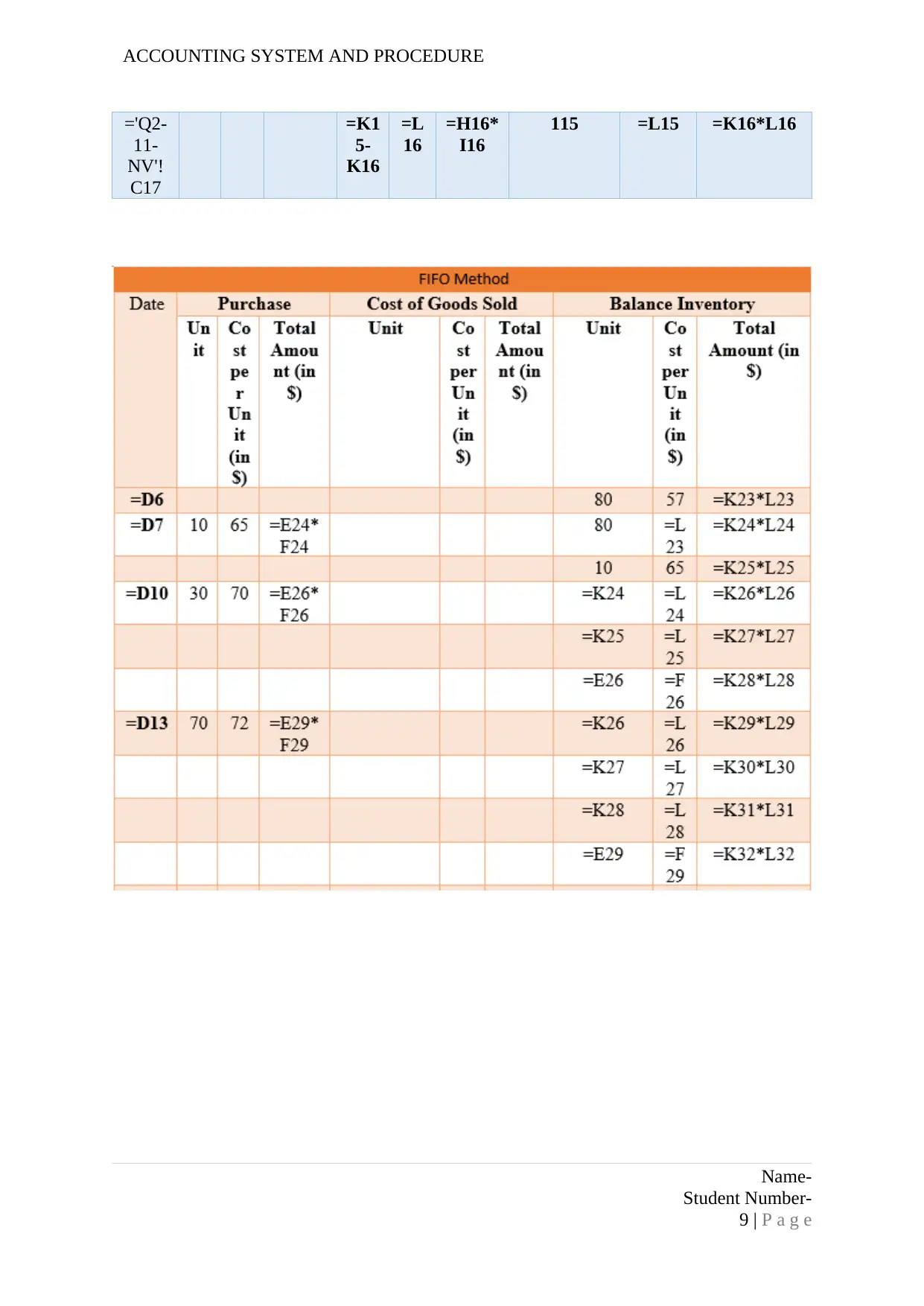
ACCOUNTING SYSTEM AND PROCEDURE
='Q2-
11-
NV'!
C17
=K1
5-
K16
=L
16
=H16*
I16
115 =L15 =K16*L16
Name-
Student Number-
9 | P a g e
='Q2-
11-
NV'!
C17
=K1
5-
K16
=L
16
=H16*
I16
115 =L15 =K16*L16
Name-
Student Number-
9 | P a g e
Paraphrase This Document
Need a fresh take? Get an instant paraphrase of this document with our AI Paraphraser
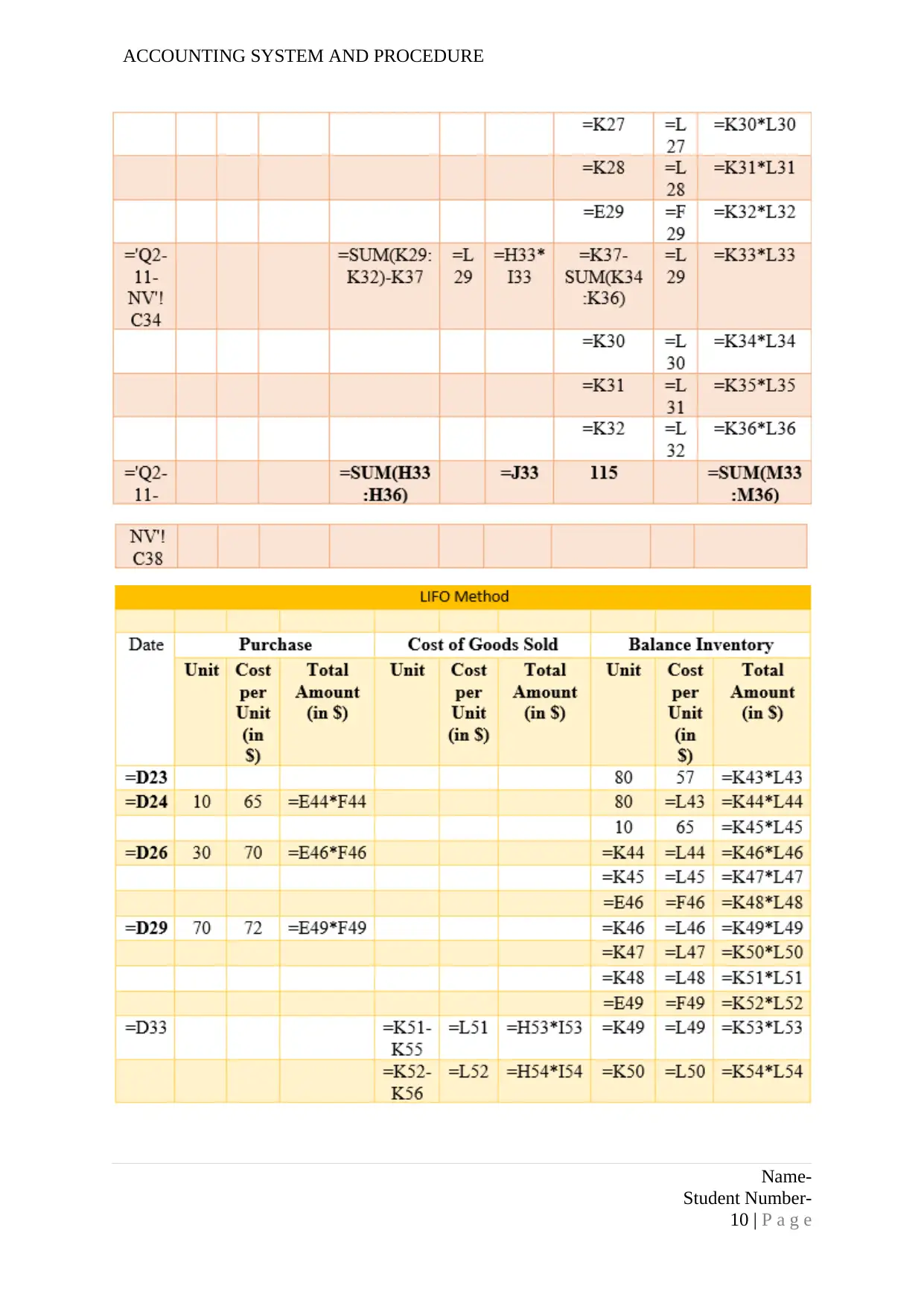
ACCOUNTING SYSTEM AND PROCEDURE
Name-
Student Number-
10 | P a g e
Name-
Student Number-
10 | P a g e
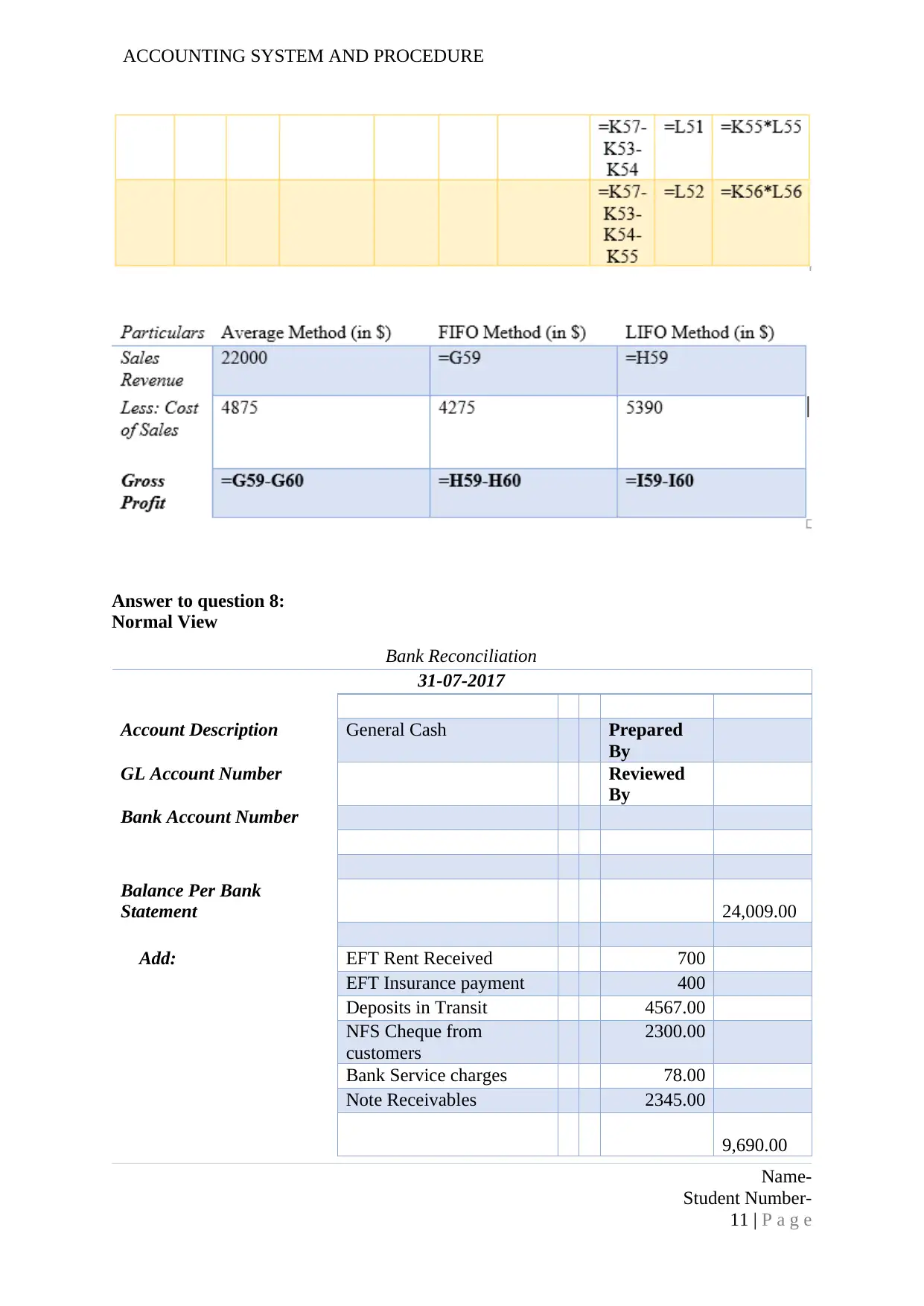
ACCOUNTING SYSTEM AND PROCEDURE
Answer to question 8:
Normal View
Bank Reconciliation
31-07-2017
Account Description General Cash Prepared
By
GL Account Number Reviewed
By
Bank Account Number
Balance Per Bank
Statement 24,009.00
Add: EFT Rent Received 700
EFT Insurance payment 400
Deposits in Transit 4567.00
NFS Cheque from
customers
2300.00
Bank Service charges 78.00
Note Receivables 2345.00
9,690.00
Name-
Student Number-
11 | P a g e
Answer to question 8:
Normal View
Bank Reconciliation
31-07-2017
Account Description General Cash Prepared
By
GL Account Number Reviewed
By
Bank Account Number
Balance Per Bank
Statement 24,009.00
Add: EFT Rent Received 700
EFT Insurance payment 400
Deposits in Transit 4567.00
NFS Cheque from
customers
2300.00
Bank Service charges 78.00
Note Receivables 2345.00
9,690.00
Name-
Student Number-
11 | P a g e
⊘ This is a preview!⊘
Do you want full access?
Subscribe today to unlock all pages.

Trusted by 1+ million students worldwide
1 out of 23
Related Documents
Your All-in-One AI-Powered Toolkit for Academic Success.
+13062052269
info@desklib.com
Available 24*7 on WhatsApp / Email
![[object Object]](/_next/static/media/star-bottom.7253800d.svg)
Unlock your academic potential
Copyright © 2020–2025 A2Z Services. All Rights Reserved. Developed and managed by ZUCOL.





